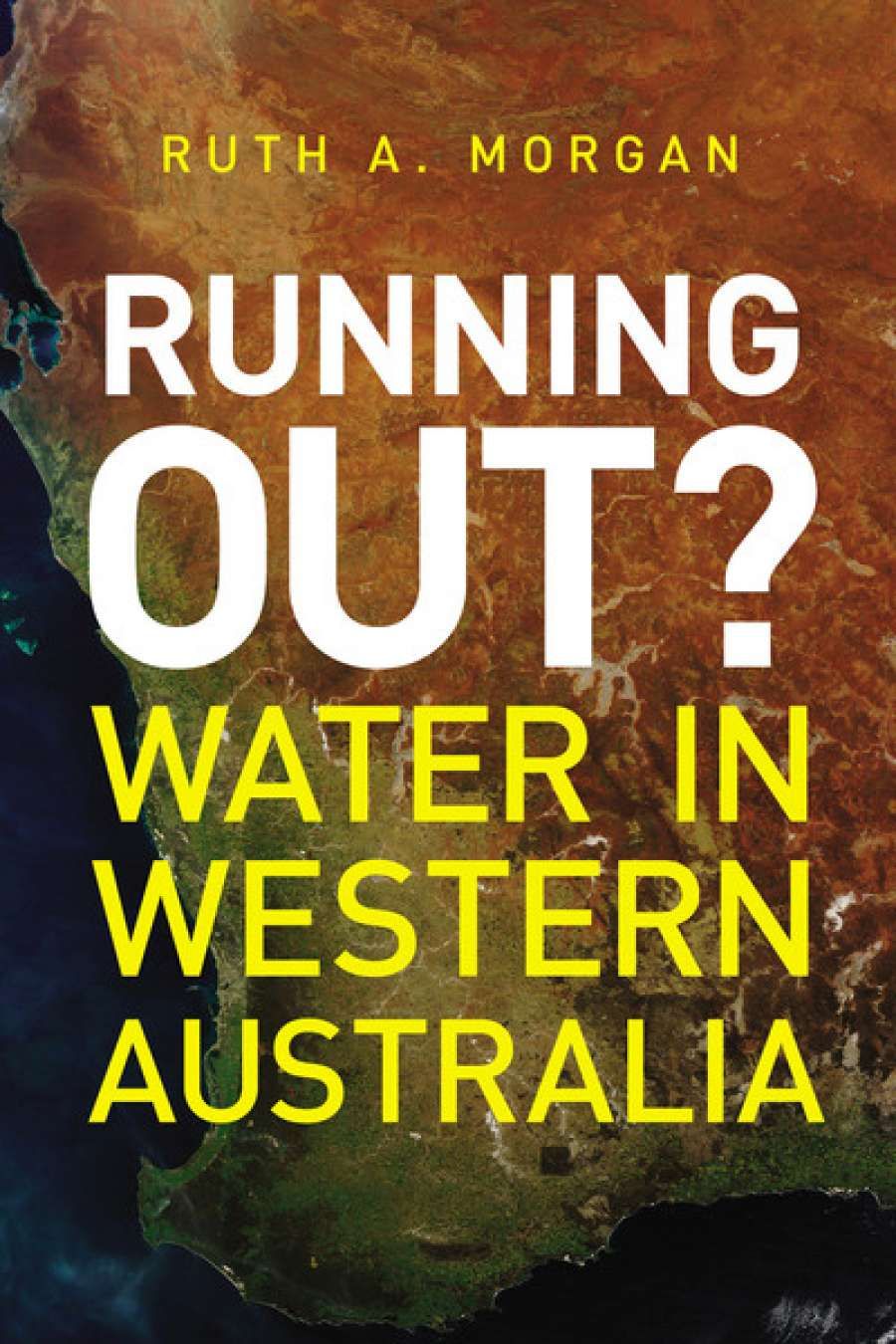
- Free Article: No
- Contents Category: Environmental Studies
- Custom Article Title: Billy Griffiths reviews 'Running Out?' by Ruth A. Morgan
- Book 1 Title: Running Out?
- Book 1 Subtitle: Water in Western Australia
- Book 1 Biblio: UWA Publishing, $34.99 pb, 320 pp, 9781742586236
As the cover suggests, the book is mostly focused on the state’s South West. Morgan moves through her history chronologically, generation by generation, allowing readers to draw their own connections across time. Her focus is on human and policy responses to environmental change, rather than on telling us about the science. She explores water as a source of conflict and competition: between the colonisers and the colonised, the city and its hinterland, conservationists and governments. She illuminates how access to water has been central to ideas of health and sanitation, wealth and privilege, whiteness, and progress.
This is a story that has played out on Aboriginal country, and indigenous Australians have a strong voice in every chapter. Morgan writes of how Aboriginal people have been repeatedly forced off their land, denied access to basic water facilities, and dehumanised as ‘filthy’ and ‘carriers of disease’. She also notes how Aboriginal wells, carved into granite and clay, played a key role in the European exploration of the state, and how they continued to be exploited by miners, prospectors, and pastoralists into the twentieth century.
When faced with environmental challenges, the new settlers came up with ambitious man-made solutions. In 1896, the engineer C.Y. O’Connor oversaw the construction of a pipeline from the Helena River near Perth to the minefields in Coolgardie and Kalgoorlie, nearly 600 kilometres away. Morgan stresses the sheer scale of the project: ‘Even the engineering schemes of ancient Rome had not been so bold as to pump water such a distance, let alone uphill.’ Similarly audacious proposals to slake the state’s thirst have included mooring Antarctic icebergs off the coast of Fremantle and loading clouds with chemicals to create precipitation (‘cloud seeding’).
 Section of the Perth-Kalgoorlie water supply pipeline near Merredin WA, 1976 (photograph by Willem van Aken, source: CSIRO scienceimage via Wikimedia Commons)
Section of the Perth-Kalgoorlie water supply pipeline near Merredin WA, 1976 (photograph by Willem van Aken, source: CSIRO scienceimage via Wikimedia Commons)
Water consumption in Western Australia escalated at a dramatic rate in the twentieth century, with each Perth resident consuming nearly twice as much in 1941 as they had in 1911. Green lawns, modern bathrooms, and pristine interiors were signs of status and prosperity. Attempts to introduce water restrictions in 1919–20 were met with fierce community backlash. The Daily News labelled it a ‘humiliating’ policy and called for ‘another set of Ministers … more given to exercise of initiative in big things’.
‘Water consumption in Western Australia escalated at a dramatic rate in the twentieth century’
It was this same belief in ‘big things’ that drove the rise of the modern water regime – ‘Big Water’ – in the postwar years. Big Water quenched the prodigious thirst of the state’s postwar economic program by promising an infinite water supply, independent of climate and seasons. And it was a Big Success. Nation building was water-intensive work. Between the end of the war and the mid-1970s, water consumption in Perth almost tripled.
The water crisis of recent decades reveals much about how the state has viewed its relationship to the environment. As the drying trend set in, instead of curbing the policies of Big Water or imposing unpopular water restrictions on a thirsty electorate, successive state governments encouraged residents to supplement their water supplies with unlicensed, unmonitored backyard bores. The exploitation of this subterranean bounty softened the impact on stored water in dry years, but it put groundwater reserves at risk and did little to tackle the culture of unfettered water use. As residents continue to draw thirstily from aquifers beneath the city, Perth is slowly sinking.
‘Big Water quenched the prodigious thirst of the state’s postwar economic program by promising an infinite water supply’
Morgan’s final two chapters are written with a sense of urgency. Water scarcity, she reminds us, is about quality as well as quantity. Western Australia has the highest proportion of marginal, brackish, and saline surface water in the country. Over fourteen thousand hectares of land are lost to secondary salinity each year.
Is desalination the ‘silver bullet’ that will end the state’s water woes? Morgan does not believe so. It is another Big Water solution, promising an infinite supply of water independent of the environmental realities of living in the world’s driest inhabited continent. Instead of pipe dreams, Morgan advocates conservation measures that are best described as ‘Small Water’: personal rain tanks and grey water reuse; dual flow water systems and recycled wastewater. It is sound advice, dredged from the depths of past experience, with applications far beyond Western Australia.


Comments powered by CComment